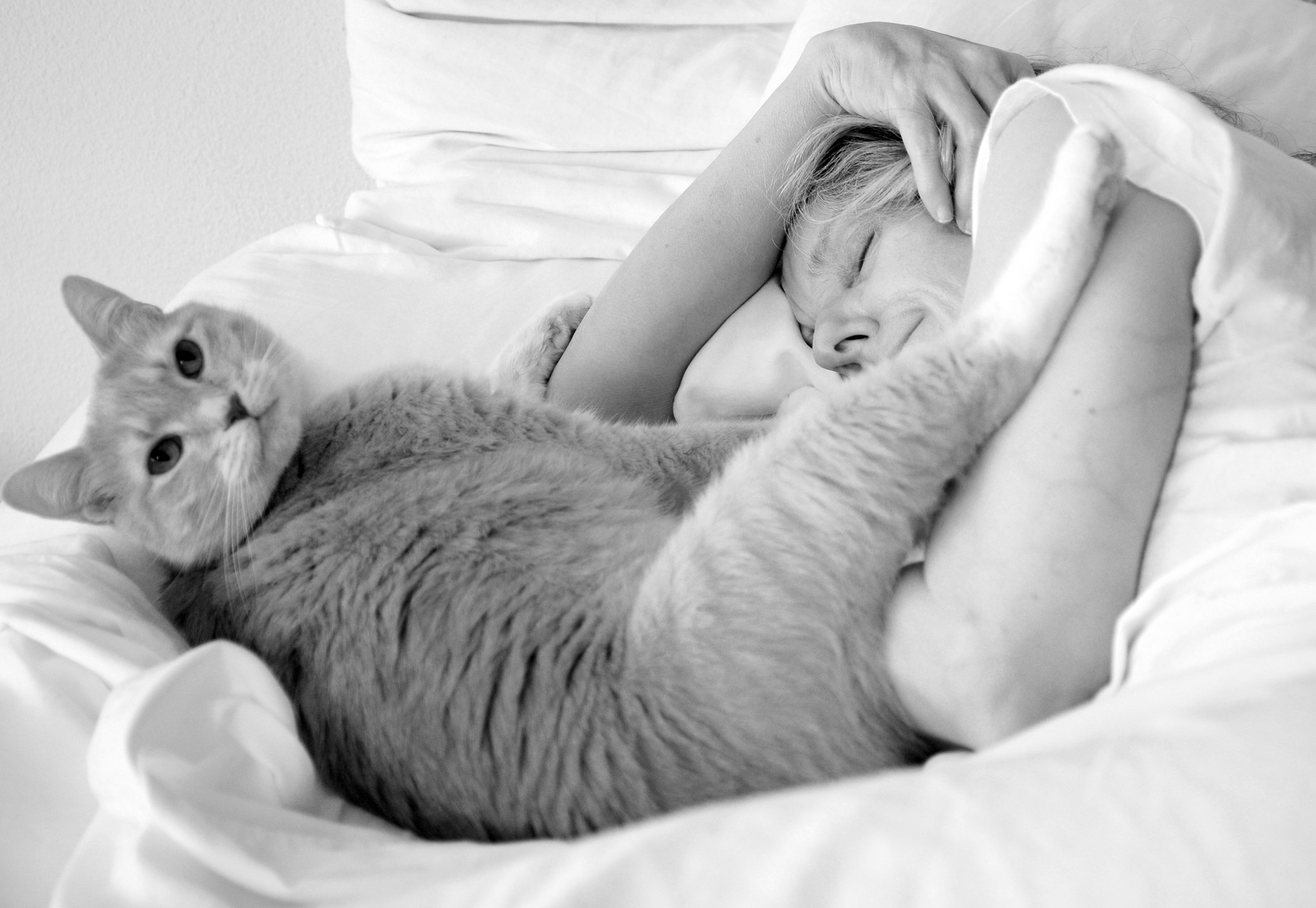Your aging cat seems to be sleeping an awful lot, he doesn’t jump up on the furniture as much as he used to and he seems to be less meticulous about grooming. Sometimes he’s sensitive in certain areas or displays odd behaviors. Should you assume that he is just settling into the senior years — or should you worry that something is wrong?


Thinkstock
Too often, people assume that cats normally become less active with age — but in reality, such changes in a cat’s behavior can be subtle signs of chronic pain from injury or illness. Tufts Cummings School of Veterinary Medicine pain specialist Alicia Karas, DVM, explains that conditions that can cause chronic pain include cancer, glaucoma, trauma (such as being hit by a car), the onset of osteoarthritis, and inflammation from diseases such as pancreatitis, stomatitis, interstitial cystitis or irritable bowel disease.
According to Dr. Karas, chronic pain is defined as discomfort that lasts beyond its usefulness — causing the cat to retreat from or stop doing whatever caused the pain, for instance — or that continues after an injury has healed. Sometimes, it results from an ongoing physical problem, such as osteoarthritis or other degenerative conditions. Although it might not be obvious, chronic pain can certainly have a deleterious effect on a cat’s well being.
Recognizing Pain
Cats are so adept at hiding their discomfort that it can come as a surprise to owners — and even to some veterinarians — to discover that they might be in pain. For instance, caring cat owners aren’t always aware that syndromes such as glaucoma or diabetes can be accompanied by pain. Chronic pain is commonly under-diagnosed, explains Lisa Moses, VMD, an internal medicine specialist who leads the pain medicine service at Angell Animal Medical Center in Boston, MA.
Behaviors that point to pain
Many behaviors can indicate pain in cats. They include decreased grooming or grooming that focuses intensively on certain areas; changes in sleep patterns or locations; changes in the cat’s posture when she sits or sleeps; hiding; changes in litter box habits; a new reluctance to be petted or groomed; difficulty in jumping on or off furniture; and a poor appetite. Anything that isn’t normal for a particular cat should be considered a possible sign of pain and should be brought to the attention of your veterinarian as soon as possible.


Thinkstock
Different conditions can elicit different types of pain, and they don’t always manifest the same way in cats as they do in dogs. A good example is degenerative joint disease. In cats, lameness is not a common clinical sign. More typically, owners see changes in a cat’s functional mobility, such as trouble rising or less willingness to jump on a favorite chair or his owner’s bed.
Many common feline diseases can cause chronic abdominal pain. Cats with this type of pain may not eat well or are nauseous and lethargic. Unless the pain is severe and constant, though, it may not be obvious when the veterinarian palpates the cat.
Consider chronic pain as a possible culprit any time a cat’s functional mobility and/or behavior changes, when clinical signs of pain persist despite treatment, or if the cat has certain chronic diseases, such as pancreatitis. Preventing it should also be a factor any time a cat must undergo surgery.
Managing chronic pain
Chronic pain can be treated, but it’s not always easy. The first obstacle is lack of recognition. Once it is identified, the level of pain can be difficult to assess. Finding a medication that works well for cats on a long-term basis is sometimes a problem. Fear that the treatment will cause side effects can be an issue, as can getting medication into the cat for what must often be the rest of her life. Fortunately, there are good ways to overcome these obstacles.
Ways to identify and determine the level of pain include keeping a diary of the cat’s behaviors. This can help you and your veterinarian establish how well the cat is able to move, known as functional mobility. Your veterinarian may provide a questionnaire for you to fill out, or you can bring your own notes on the cat’s ability or willingness to get in and out of the litter box, jump on or off the bed or other normal actions that may be affected by pain.
Managing chronic pain usually involves several types of therapy that work together to help relieve discomfort. A combination of medication and physical therapies such as acupuncture, massage or other rehabilitation techniques is usually most effective. Some trial and error may be necessary to find what works best, however.
Medication options
Cats often respond better to pain therapy than dogs, but finding medications appropriate for feline physiology can be challenging. Some medicines that are commonly used in dogs cannot be used for cats, or must be used differently in cats. And sometimes the formulation of the medication is a problem. Dr. Karas gives as an example a cat she treats for chronic pain from an old injury. One of the medications the cat takes must be specially formulated because the regular pills aren’t small enough. “We have a compounding pharmacy make it in a fish flavor. They’re putting it in the food and the cat is eating it, but some cats are really a challenge about that,” explains Dr. Karas.
A number of non-steroidal anti-inflammatory drugs have been studied and approved for use in dogs, but only two — meloxicam (Metacam) and robenacoxib (Onsior) — are approved for use in cats and only for acute pain, not chronic pain. That hampers veterinarians in terms of their ability to use those drugs, Dr. Karas says, but they are finding that other types of drugs can help relieve pain in cats.
One such drug is gabapentin, an anti-seizure medication that was found serendipitously to be effective for pain. An antidepressant called amitriptyline can help animals with chronic bladder pain. Tramadol, widely used in humans, has several different actions that benefit cats with chronic pain.
None of the drugs are perfect, however. The 100-mg gabapentin pills are too large a dose for cats so the drug must be compounded or divided or made into a suspension that’s safe for cats. The use of tramadol is complicated by its bitter taste. And some cats don’t tolerate amitriptyline well. To treat chronic pain, Karas has also used other antidepressant -type drugs such as Prozac in cats as well as antidepressants specifically developed for cats with behavior problems, giving lower doses than for behavioral use.
Help for arthritis
Cats with arthritis can be treated with what are called disease-modifying drugs. These include Cosequin, an oral joint supplement made for cats, and Adequan, an injectable joint supplement. (Adequan is approved for use in dogs, but has been used off-label in cats to good effect.) Fish oils and other supplements can also be helpful, but you should discuss any supplementation with your cat’s veterinarian first. (See related article on page 6 of this issue.)
Some drugs aren’t traditionally thought of as pain relievers, but their use in treating a disease can have the effect of reducing pain. For instance, some antibiotics such as metronidazole have an anti-inflammatory effect. It can be helpful for conditions such as stomatitis, a painful mouth disorder.
Surgery for some
Sometimes surgery is an option. Malignant tumors are often removed for palliative purposes – in other words, to relive pain. Certain orthopedic conditions can be treated with surgery, physical rehabilitation and medication.
Don’t rule out seemingly drastic measures such as removing all the teeth of a cat with severe stomatitis or removing the eye of a cat with glaucoma. Dr. Karas says veterinarians often hear from owners that cats who undergo those procedures are more active and happy afterward.
“They’ve had that chronic pain hanging over them, and once that was gone and the surgery has healed, they found their behavior so much less inhibited by pain,” she says.
Environmental changes
A cat with chronic pain can also benefit from modifications to its home and, if she is overweight, from weight loss. Adjustments include providing ramps or steps to furniture; improving access to the litter box by either cutting an entry way at one end so the cat can simply walk in and out or providing a step into the box; purchasing a temperature-controlled bed that provides warmth to soothe achy joints; and assuring that your cat has access to a cool place to lie on hot days.
Weight management is also important. Excess weight stresses joints and makes it more painful and difficult for the cat to move comfortably. Provide short, two- to five-minute sessions of gentle exercise and play to help your cat shed pounds. Electronic mice, balls that light up as they move, laser pointers and catnip-infused stuffed toys that make a crinkling sound when pounced on will all encourage him to move. After consulting your veterinarian, cut back on the amount of food she receives, and encourage more activity by putting her daily ration inside a puzzle toy so she has to work to get at it.
Physical rehabilitation
A cat on an underwater treadmill? Or getting a massage? It happens, and it’s helpful for cats with chronic pain. If you have access to a pet rehab clinic and your cat doesn’t mind regular car rides, these therapies can help her build muscle, which in turn supports joints and improves mobility.
“I have one client who was pulling out all the stops for her older cat,” Dr. Karas says. “She took him to a rehab specialist who was swimming him and doing massage, and the cat had a really good response to that. If there is a rehab facility in your area that sees cats, I think that’s something to think about.” — Kim Campbell Thornton




